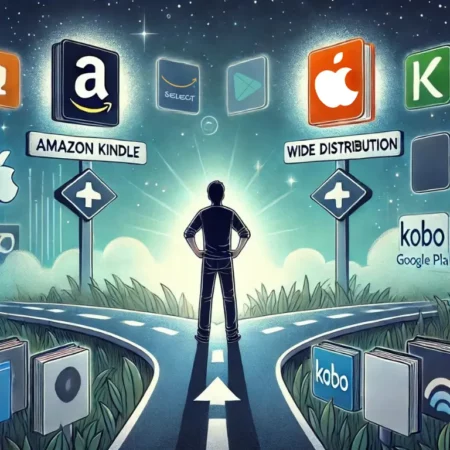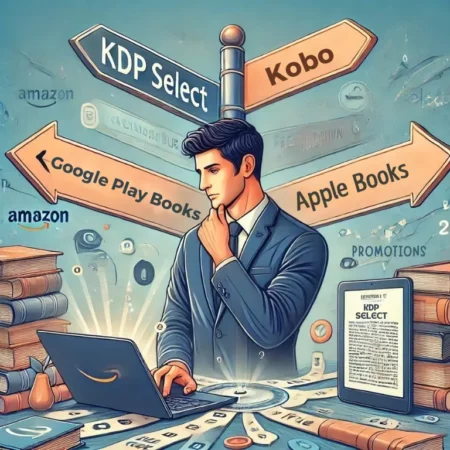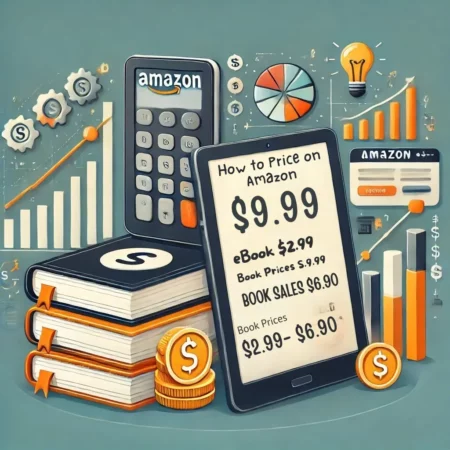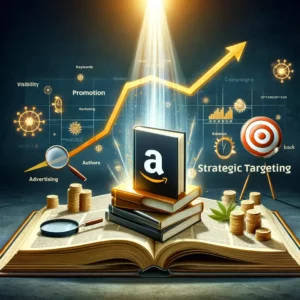In the realm of self-publishing, one name shines like a beacon of opportunity for authors worldwide – Amazon Kindle Direct Publishing (KDP). This dynamic platform offers an unparalleled gateway to reach readers, bridging the gap between authors and their audience. But in this digital bazaar, where literary dreams come to life, there exists a critical juncture that can shape your journey – pricing.
Navigating the Path to Success
Authors, both seasoned and aspiring, often find themselves at a crossroads when it comes to pricing their literary creations on Amazon KDP. It’s no secret that pricing plays a pivotal role in the self-publishing landscape. The right price can propel your book to the best-seller charts, while the wrong one can leave it languishing in obscurity. Learn more about why authors are choosing Amazon KDP, click here.
Unveiling the Strategy
The purpose of this comprehensive guide is clear – to empower authors with the knowledge and strategies needed for pricing your book on Amazon KDP. We’ll navigate the intricacies of Amazon KDP’s pricing structure, explore the factors that influence book pricing, and provide you with proven strategies to maximize your book’s potential.
No matter where you stand in your writing journey, this article is your compass, designed to help you navigate the terrain of self-publishing with confidence. By the time you reach the end, you’ll possess the insights and tactics required to make informed pricing decisions, catapulting your book to success.
So, dear author, fasten your seatbelt and get ready to embark on a journey through the world of Amazon KDP pricing, where every word you write holds the promise of a reader’s heart.
Understanding Amazon KDP’s Pricing Structure
Decoding the Pricing Options and Royalty Rates
Amazon KDP offers authors a multifaceted pricing structure, and understanding its intricacies is the first step to pricing success. Authors can choose between two royalty options: the 35% royalty plan and the coveted 70% royalty plan. Each comes with its own set of rules and implications.
The 35% royalty plan is the default option. Under this plan, you’ll receive a 35% royalty on the book’s list price. This is an attractive option for lower-priced eBooks or if you want to distribute your book in countries where the 70% option is unavailable.
The 70% royalty plan offers a more substantial share of the royalties but comes with stricter pricing conditions. To qualify for this plan, your eBook must be priced within a specified range (usually between $2.99 and $9.99). Moreover, delivery fees apply, depending on the eBook’s file size.
The eBook vs. Paperback Pricing Dilemma
When it comes to pricing, one size does not fit all. Amazon KDP recognizes this and allows you to set different prices for eBooks and paperbacks. This distinction is essential, as the production and cost structure of these formats vary significantly.
eBooks are generally priced lower than their paperback counterparts, making them more accessible to a broader audience. However, you must strike a balance between affordability and perceived value. An eBook that’s priced too low may convey a lack of quality, while one that’s too high may deter potential readers.
On the other hand, pricing paperbacks involves considerations like production costs, shipping fees, and distribution channels. Calculating these costs and setting a competitive price point is crucial to ensure profitability without pricing yourself out of the market.
The Boundaries: Minimum and Maximum Pricing Limits
Amazon KDP imposes minimum and maximum pricing limits to maintain pricing consistency across its platform. The minimum price requirement ensures that authors don’t give away their books for free or at an unrealistically low price. This also helps prevent potential abuse of the KDP system.
Conversely, the maximum price limit is in place to prevent authors from setting exorbitant prices that could deter readers. Striking a balance between these limits and your book’s value is a delicate art, one that we’ll explore further in this guide.
Understanding Amazon KDP’s pricing structure is the foundation upon which you’ll build your pricing strategy. With these fundamentals in your arsenal, you’re ready to dive deeper into the factors that influence book pricing on Amazon KDP.
Factors Influencing Book Pricing on Amazon KDP
Book Length and Production Costs
When it comes to pricing your book on Amazon KDP, several factors come into play, and one of the most crucial ones is the book’s length and production costs. Whether you’re publishing a paperback or an eBook, the number of pages in your book can significantly impact the overall pricing strategy.
For paperbacks, page count is closely tied to printing costs. As the number of pages increases, so do the production expenses. Therefore, authors and publishers need to strike a balance between the book’s content and its potential cost to produce physical copies. This balance ensures that the book remains competitive in the market while still yielding a reasonable profit margin.
In the case of eBooks, production costs are different from printed books. However, authors should still consider factors like formatting, cover design, and editing expenses when determining the cost of creating their digital version. These initial production costs may vary, but they are essential to ensuring a high-quality eBook that can compete effectively in the digital marketplace.
Royalty Options
Amazon KDP offers two primary royalty plans for authors: the 35% royalty plan and the 70% royalty plan. The choice between these two options can significantly influence pricing decisions.
Under the 35% royalty plan, authors receive a lower royalty rate per sale but can set a lower retail price for their books. This can be advantageous for books in highly competitive markets, as it allows authors to offer lower prices and potentially attract more buyers.
On the other hand, the 70% royalty plan offers a higher royalty rate but comes with specific pricing restrictions. For instance, books must be priced within a certain range to qualify for this plan. Authors must carefully consider these pricing constraints when deciding which royalty plan suits their book best.
Market Trends and Competitive Analysis
In the ever-evolving world of self-publishing, understanding market trends and conducting a competitive analysis is paramount. Authors must research similar titles and analyze genre pricing to determine the optimal price point for their book.
Studying market trends allows authors to identify pricing strategies that have proven successful for books in their niche. It also helps them adapt to changes in reader preferences and market dynamics, ensuring that their book remains relevant and competitive.
Competitive analysis involves looking at the prices of books with similar content, quality, and target audience. Authors should consider both traditionally published and self-published works in their analysis. By pricing their book competitively within the genre while offering unique value, authors can position themselves for success on Amazon KDP.
Pricing your book on Amazon KDP requires a thoughtful assessment of factors such as book length, production costs, royalty options, and market trends. By carefully considering these elements, authors can make informed pricing decisions that maximize their book’s visibility, sales potential, and profitability in the competitive world of self-publishing. For a more in-depth look at the Amazon publishing process, click here.
Strategies for Pricing Your Book
Setting the Right Price for eBooks
Pricing your eBook appropriately is crucial to maximize royalties and ensure your book’s success. Here are some strategies for setting the right price for eBooks:
Ideal Pricing Ranges: Research and analyze the pricing of eBooks in your genre. Look for books with a similar page count, target audience, and content quality. Identify a pricing range that is competitive within your niche. While you have the flexibility to set your eBook’s price, it’s essential to stay within this competitive range to attract potential readers.
Balancing Affordability and Perceived Value: It’s vital to strike a balance between affordability and the perceived value of your eBook. Pricing your eBook too low may make it appear less valuable, while pricing it too high may deter potential buyers. Consider the uniqueness of your content, your author brand, and the market’s expectations when determining the optimal price point.
Pricing Paperbacks Competitively
Pricing printed copies of your book, whether through print-on-demand or bulk printing, requires a different approach. Here are strategies for pricing paperbacks competitively:
Calculating Costs: Calculate the production costs of your paperback, including printing, distribution, and any associated fees. Ensure that your retail price covers these expenses while providing a reasonable profit margin. Keep in mind that competitive pricing can often lead to higher sales volume, which can offset lower profit margins per unit.
Comparing Print-on-Demand vs. Bulk Printing: Consider the advantages and disadvantages of print-on-demand (POD) and bulk printing. POD offers flexibility and eliminates the need for upfront investments, but per-unit printing costs can be higher. Bulk printing, on the other hand, can reduce per-unit costs but requires a larger initial investment. Evaluate which option aligns better with your budget and sales projections.
Dynamic Pricing and Promotions
Dynamic pricing and promotional strategies can be powerful tools for maximizing book sales. Here’s how you can leverage them effectively:
Using Promotional Pricing Strategies: Consider implementing various promotional pricing strategies to boost initial sales and attract attention to your book. Examples include launch discounts, limited-time offers, and bundling deals. These promotions create a sense of urgency and incentivize readers to make a purchase.
Adjusting Prices Based on Sales Performance and Feedback: Monitor your book’s sales performance and gather feedback from readers. If your book is not selling as expected, consider adjusting the price to attract more buyers. Additionally, pay attention to reviews and reader comments to identify any concerns about pricing and perceived value. Flexibility in adjusting your pricing strategy can help you optimize sales over time.
Pricing your book on Amazon KDP requires a thoughtful approach that considers the format (eBook or paperback), production costs, competition, and reader expectations. By setting the right price for your eBooks, pricing paperbacks competitively, and strategically using dynamic pricing and promotions, you can increase your book’s visibility and sales potential, ultimately maximizing your success as an author on Amazon KDP.
Example Pricing Question
How Much Should I Charge for a 300-Page Book?
Setting the right price for your 300-page book on Amazon KDP depends on various factors. Here are practical pricing examples for both eBook and paperback formats:
eBook Pricing: For a 300-page eBook, you might consider a pricing range between $2.99 and $9.99. This range aligns with Amazon’s royalty structure, allowing you to earn a 70% royalty rate for books priced within this range. Keep in mind that pricing closer to $2.99 can attract budget-conscious readers, while $9.99 may be suitable for established authors or books with a strong following.
Paperback Pricing: Pricing a 300-page paperback involves considering production costs, distribution fees, and your profit margin. Depending on these factors, you might set the paperback price between $10.99 and $19.99 or even higher for premium editions. Ensure that the retail price covers production costs and still provides a competitive edge within your genre.
Earnings Per Book on Amazon KDP
Earnings on Amazon KDP can vary widely depending on factors like pricing, royalties, and sales volume. Realistic earnings expectations for authors on KDP range from a few hundred dollars to several thousand dollars per month. It’s essential to keep in mind that self-publishing success often requires multiple books, effective marketing, and time to build a reader base.
Minimum and Maximum List Price on KDP Amazon KDP provides guidelines for setting the lowest and highest prices:
Minimum List Price: Amazon sets a minimum list price based on factors like printing costs and royalties. For eBooks, it’s typically $0.99, and for paperbacks, it varies based on production costs. Ensure your pricing exceeds this minimum to publish your book.
Maximum List Price: While there isn’t a strict maximum list price, Amazon may limit the maximum price based on factors like file size for eBooks or production costs for paperbacks. Be aware that excessively high prices may deter potential readers, so it’s essential to strike a balance between profit and affordability.
Pricing your 300-page book on Amazon KDP should consider factors like format, production costs, royalties, and reader expectations. Understanding KDP’s royalty structure and having realistic earnings expectations can help you make informed pricing decisions that maximize your success as an author in the self-publishing world.

Conclusion
In conclusion, pricing your book on Amazon KDP is a multifaceted process that involves considering factors such as book length, production costs, royalty options, market trends, and competitive analysis. Striking the right balance between affordability and perceived value is crucial for success. Whether you’re publishing an eBook or a paperback, remember that the right price can significantly impact your book’s sales and profitability.
Authors are encouraged to experiment with different pricing strategies to find what works best for their unique circumstances. It’s a dynamic process that may require adjustments over time based on sales performance and reader feedback. Don’t be afraid to try promotional pricing, explore different royalty plans, and closely monitor your book’s performance to optimize your pricing strategy. With diligence and adaptability, you can maximize your success as an author on Amazon KDP.
Additional Resources
For further learning and support in your Amazon KDP pricing journey, we recommend exploring these valuable resources, tools, and communities:
Amazon KDP Support: Official Amazon KDP Support provides a wealth of articles, guides, and FAQs to assist authors with various aspects of self-publishing, including pricing.
KDP Community: Join the KDP Community Forums to connect with fellow authors, share experiences, and seek advice on pricing strategies and other self-publishing topics.
KDP Pricing Calculator: Use the Amazon KDP Pricing Calculator to estimate royalties and pricing for your eBooks based on various factors.
Publisher Rocket: Publisher Rocket is a powerful keyword and category research tool that can help you optimize your book’s metadata and improve its visibility on Amazon.
Reedsy Learning: Explore Reedsy Learning for free courses on book marketing, pricing strategies, and other aspects of self-publishing.
These resources will enhance your understanding of Amazon KDP pricing and provide valuable support as you navigate the world of self-publishing.











